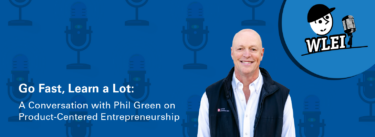This essay was first published in Gemba Walks (Expanded 2nd Edition) by Jim Womack.
Most of the work of LEI and the lean movement has been devoted to transforming “brownfields.” We have toiled at old facilities (whether factories or engineering offices or retail stores or hospitals) in old organizations (in practically every industry you can think of) with mature product concepts that have gone a long way down the path of modern management and mass production. The car industry, from which lean thinking emerged, was populated with precisely these types of organizations.
We have tried to introduce lean tools and new management mentalities in a wide range of mature organizations, including methods for developing new products. And we have had considerable success to the benefit of society. Mature enterprises in mature industries account for the vast majority of economic activity, despite the focus of the media and the blogosphere on exciting new concepts.
However, I consider our efforts to date as “rework”—not just for individual products or processes but for whole enterprises. Someone needs to do this work. But it is always hard work because we are effectively asking organizations to start over, to go back to their youth—at a point before they made their first mistakes—and to head down a different path.
It is therefore exhilarating to think instead about startups: new organizations yet to make their first mistakes. I believe that most organizations are born “lean.” They start with only a few employees in one room, a clear founder vision, face-to-face communication with no functional silos, and a horizontal flow of value from concept to launch, often across a tiny team. The challenge is to think through the approach to work, the type of management, and the nature of leadership needed to “grow up” these start-up enterprises so they don’t head down the cul-de-sac of modern management and mass production.
I’m not the only one to think this. There is now a worldwide “lean startup movement” that is worthy of attention. The canonical text is Eric Ries’ The Lean Startup: How Today’s Entrepreneurs Use Continuous Innovation to Create Radically Successful Businesses (New York: Crown Business, 2011). I commend it to everyone in the Lean Community, not because I agree with all of it but because I find it very stimulating in rethinking basic lean concepts for new circumstances.
Ries and his collaborators start by suggesting new ways to define (or redefine) value from the perspective of the customer. (This is the first principle of lean thinking as Dan Jones and I explained in Chapter One of Lean Thinking.) Getting value right is particularly important to Ries because he comes out of the social media startup world where the value of any product can only be determined by letting potential customers play with it and test it with others in their social networks.
This is a tough challenge, since developing fully refined prototypes for customer tests is expensive and time-consuming in a situation where the very concept of the product may be wrong. That’s why as a countermeasure Ries proposes the concept of the “minimum viable product” (MVP), a test product containing only the minimum functionality the customer needs to understand the product concept. This MVP is put in customer hands much earlier than traditional products would be, enabling the provider organization to learn what customers really value, while avoiding the waste of expensive and time-consuming efforts to develop fully elaborated products no one wants.
A second challenge arises once the product is launched: Is the rate of adoption great enough to sustain a viable, growing business? Are customers just responding to the buzz of the moment or are they incorporating the product into their lives? Ries and his collaborators therefore propose new ways to test product success, through cohort analysis of each new tranche of customers attracted to a product as it evolves, and with split tests of new product variants.
Finally, because the organizations Ries works with are mostly venture capital funded and working in highly dynamic markets, these startups face daunting deadlines in proving the value of their products. Their investors expect nine of 10 ventures to fail and are always ready to pull the plug even as the managers deny the reality of their situation. Ries has developed additional methods for “innovation accounting” to judge “the rate of validated learning” so that managers and investors can make more rational decisions about whether the rate of learning about customers is sufficient to stay the course, “pivot” to a new approach to the customer, or abandon ship.
Note that the MVP, cohort analysis, and innovation accounting with validated learning concepts do not apply just to software apps, as many in the Lean Community might think. Different industries with different customer expectations all need different definitions of an MVP, just as they need different ways to determine the success of their initial product, and different ways to decide if their basic course is right. These tasks must be performed in some way and today they are mostly being performed through anecdotal evidence and hunches rather than science.
I believe the Lean Startup movement and the Lean Community have the potential for a productive conversation once startups prove their product concept. This is when they begin to grow up, adding all of the complexity of a mature business, including deep vertical functions with many employees (marketing, engineering, production, purchasing, customer service) and a portfolio of products at different stages of maturity flowing horizontally across these deep functions to reach customers. Ries does have some advice in the last section of The Lean Startup for enterprises reaching this point, but to use a favorite phrase of the Lean Startup community for judging performance metrics, is this advice “actionable?” For example, he gives advice on how to begin training managers and engineers about the company’s culture, how to develop robust procedures that help employees do a good job consistently but not block their creativity, and how to do problem solving with his version of the “Five Whys” as adapted from Toyota.
But it’s all very vague and approximate. It’s not a lean management system, which consists of responsible leaders for each product value stream, current-state and future-state maps of each stream, standardized work for every process (developed and continually updated by every work team), and rigorous yet easily understood methods for framing both problems and opportunities by means of A3 analysis that incorporates the Five Whys and PDCA.
These are not trivial additions around the margins of start-up management. They form the core practices of a mature lean organization as it tries to avoid the strangulation of top-down authority while maintaining control of the progress of every product as it flows from concept to customer across deep functions.
Beyond the basic management system, there are important lean enhancements needed in every function as the value proposition for each family of products become clear. In the case of product and process development (and note that these should always occur together) the needed methods are described quite brilliantly in the late Al Ward’s book Lean Product and Process Development (2007). (Note: This volume will be reissued in 2014 in an expanded version, with the help of Al’s longtime student, Professor Durward Sobek.)
When Al’s key concepts of the entrepreneurial system designer, the team of responsible experts, set-based concurrent engineering, and truly rigorous cadence, pull and flow are added to the methods Ries describes for startup developers there is a much better chance that an organization will grow to maturity with no need for pushing the reset button.
To test these ideas and determine just how early in the life of a startup they can be applied, we at LEI have been working with a new venture that seeks to reconfigure the entire business eco-system in which it operates and whose value for the customer is derived mainly from this reconfiguration. We have been observing firsthand the challenge of creating an MVP for a molecular product in a molecular environment where “minimal” cannot be not very minimal (although still much more minimal than traditional product engineers would like). This means that early users of the real product need to be partners as well as customers and intense feedback loops need to be built in for rapid response to learning. At the same time we are observing how a lean management system can be installed very early that stabilizes core processes (through standardized work), focuses everyone touching the processes on rapid problem solving (through A3), and yet maintains the ability to “pivot” as learning continues (via a dynamic hoshin process).
An even bigger challenge for an organization growing up is to rapidly create a complete lean enterprise that combines a lean product development process and a lean production process with external partner/suppliers and partner/customers. How can the success of this whole enterprise be evaluated beyond often misleading metrics like sales growth? How can the amount of learning per unit time be measured and how can all this learning be turned to good use?
This said, I wish the Lean Startup movement (not to mention the startups we are studying) every success. And I hope we in the Lean Community can be in close dialogue with the Lean Startup movement in the future. We still have many ideas to share about lean management from the transition point from start up to grow up.
To sum up: Starting up and growing up are two phases necessary for every organization. Lean thinking has traditionally been very strong on the second phase and the Lean Startup community is adding important concepts to strengthen the first phase. If managers get these two phases right they will never need for a third phase, the organizational rework of starting over. This, to cite Ries’ phrase from another context, is the land of the “walking dead” where mature organizations often manage to survive but create much less value and much more waste than they should. Surely working together—Lean Startup movement and the Lean Community—we can do much better.






